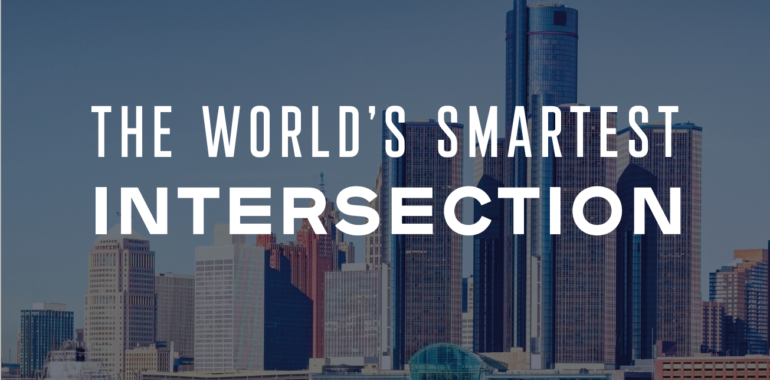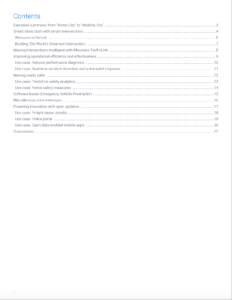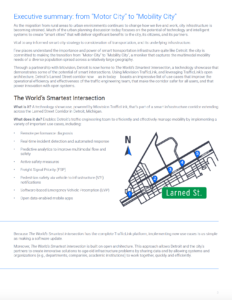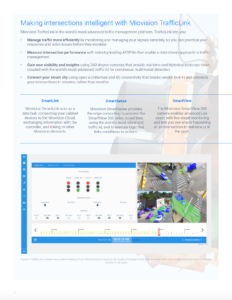Telling a Miovision Technology Story
Like many things do, this project started over lunch.
Matt Trushinski and I worked closely together for a few years at Sandvine; while catching up over taco bowls, and without getting into specifics, Matt alluded to an upcoming, very large, marketing program built around a major project that Miovision were announcing in a couple of months’ time. They were doing some cool things, and would be revealing some of those things at a tradeshow at the beginning of June. Most of the marketing activities they’d planned by this point (early April) were what we’d variably call “top of funnel”, “demand generation”, and the like.
While top-of-funnel content is undeniably important (after all, it’s this content that starts the conversations), Matt and I both had a well-earned appreciation for the importance of content that goes a bit deeper: invariably, interested prospects ask questions; frequently, these questions are very detailed and very technical in nature. To help prospects move quickly through the buying cycle, it’s useful to be able to answer these questions quickly (while they’re excited!) and with scale (for instance, with a piece of content, rather than needing to schedule meetings with a subject matter expert).
Invariably, interested prospects ask questions; frequently, these questions are very detailed and very technical in nature. To help prospects move quickly through the buying cycle, it’s useful to be able to answer these questions quickly and with scale.
Anticipating the need for some deeper, technical content to immediately address questions from interested prospects, Matt asked if I’d be available to write a technical showcase to be available at launch.
Kicking It Off
At the end of April, the project – The World’s Smartest Intersection – had progressed sufficiently that it made sense for Matt and I to meet up again to get a bit more specific.
I joined him at the eye-catching Miovision headquarters in The Catalyst and, joined by a couple of Matt’s colleagues, we got to work. Matt gave me an overview of The World’s Smartest Intersection: the goals of the project, the details, the use cases, and so on. I had some familiarity with Miovision’s tech, which gave me enough of a starting point to start asking reasonably informed question.
Ultimately, we decided that what was needed to support the launch was a technical showcase document that would go behind-the-scenes on a use case-by-use case basis. That way, a prospect who got excited about some featured use case within The World’s Smartest Intersection and who asked “How does it work?” could simply download and read the showcase. With this showcase, we’d specifically address a known buying barrier: someone involved in a potential purchase wants to know how the solution works, and the whole engagement can halt until those questions are answered.
A prospect who got excited about some featured use case within The World’s Smartest Intersection and who asked “How does it work?” could simply download and read the showcase.
We spent the last half hour of the meeting running through each use case; as Matt explained things, I madly diagrammed how the components integrated and how the workflow of each use case played out. A few questions here, a few answers there, and I had what I needed to start writing.
To the Keyboard!
Ultimately, much of the content was dependent upon results and images from the actual deployment in Detroit, but in the meantime there were nevertheless a few things I could take care of.
First, I wrote most the paper’s front matter: this introductory material drew upon some material I’d read recently about the economic impact of cities, combined with information I’d found about Detroit’s own smart city initiatives, and mixed in with some information I dug up on the United States Ministry of Transportation’s programs; it also introduced the Miovision components that would be referenced later in the document.
Second, I wrote out workflow descriptions of how each use case was actually implemented. I also reached out to a graphic designer to ‘commission’ a series of rendered isometric intersection graphics, including vehicles, pedestrians, landscape features, etc. I really wanted to bring these use cases to life!
After those pages were written, I had the skeleton of a document, but it was still missing the meat that would come from the real-world deployment.
Crunch Time
Over the next few weeks, not much happened on my end. Things were different on the Miovision side, as folks were fervently building, testing, and refining the real-world implementation. Because the use cases are built on a common platform, the Miovision team could implement them one-by-one through software configurations, rather than the antiquated (but still commonplace) approach of digging holes in the ground to install new equipment for each new thing an intersection needs to do.
Because the use cases are built on a common platform, the Miovision team could implement them one-by-one through software configurations, rather than the antiquated (but still commonplace) approach of digging holes in the ground.
Complicating matters only slightly, I was traveling on the West coast during ‘crunch time’; in practice, this minor inconvenience just meant that I had to make time here and there to incorporate new information, results, images, etc. into the document. As input came in, I did just that and sent Matt a final draft version before my return flight two days prior to the big launch.
That may sound tight, but a) results were still coming in, so earlier wasn’t an option; and b) Matt and I worked together long enough to know that it was actually plenty of time – we make an effective team!
That’s the fun thing about writing about real-world installations, demonstrations, etc. – you really can’t finish until the actual implementation is finished, so all you can do in the meantime is make sure you’ve taken care of everything else; you build in blanks that need to be filled, and you have a reasonable expectation of what’s going to come, and when, but you have to be accommodating to an ever-changing reality.
That’s the fun thing about writing about real-world installations, demonstrations, etc. – you really can’t finish until the actual implementation is finished, so all you can do in the meantime is make sure you’ve taken care of everything else.
Over the Sunday and even Monday morning, Matt and I exchanged a few back-and-forth emails as we refined the paper into its final form. A language tweak here, a real-world stat there, an awesome portal screenshot on that page, etc. In my experience, the refinements often take the longest and matter the most. You can bang out 90% of a 20-page document in a few hours because that’s a bulk production activity, but getting it over the finish line in its best possible form takes care, attention, time, skill, experience, and patience.
In my experience, the refinements often take the longest and matter the most..getting it over the finish line in its best possible form takes care, attention, time, skill, experience, and patience.
Success Factors
I’m happy to say that Miovision’s big reveal went spectacularly well, and Matt reported that the technical showcase document we produced was serving its vital purpose very capably.
So, what factors contributed to the project’s success?
Above all, at least in my opinion, was Matt’s experience: he knew the importance of bottom-of-funnel content, so he spearheaded this technical showcase project and ensured other folks within Miovision understood why it was a vital tactic of the overall launch.
Matt knew the importance of bottom-of-funnel content, so he spearheaded this technical showcase project and ensured other folks within Miovision understood why it was a vital tactic of the overall launch.
Second, I’d be remiss if I didn’t say that Miovision came to the table with a terrific set of resources. They provided me with:
- Their messaging and positioning guidelines for The World’s Smartest Intersection, as those guidelines evolved: this material ensured the technical showcase was consistent with and supported the overall program message
- One of the best brand guidelines document I’ve seen so far in my career (produced by Stryve Marketing, btw): this comprehensive guide explained proper use of the logo, of graphics, and all that usual stuff, but went deeper – it covered language style, terminology, capitalization, and more; these guidelines ensured this technical showcase was consistent and coherent with Miovision’s wider collection of material
- Material that explained, in detail, the various measurements, metrics, and visualizations that form the language of traffic engineers: this stuff served as a crash course and prepared me well to interpret and discuss the real-world results
- Templates, graphics, and the like: having this material available both speeds up execution and increases consistency with the rest of the Miovision portfolio
- Fast responses/turn-around: everyone understood that rapidly turning things around was vital both to meeting our deadline and to integrating new results and information into the final paper
Finally, a big factor here was trust: Matt and I had a great working relationship when we were on the same team, so we knew exactly what to expect from each other as this project puttered along. We could get in touch with each other if/when needed, we could provide and accept honest feedback, and so on. On a project like this one, where things can get a bit hectic as a very hard deadline approaches, it’s great to know that you don’t have to worry.
In Closing…
This project was fun! Telling a technology story is one of the things I most enjoy, and this project let me scratch that itch.
Seeing what’s possible with their platform, and knowing its clear advantages over traditional approaches and solutions is actually a bit of a curse.
Plus, I got to learn, which is a very strong driving force in my life. While I’ve been somewhat ‘adjacent’ to Miovision for years, even going back to their very inception, I’d never really closely examined their solutions. And let me tell you, it was eye-opening! Seeing what’s possible with their platform, and knowing its clear advantages over traditional approaches and solutions is actually a bit of a curse, because I’m constantly infuriated whenever I see something silly happening in the real world: from lousy corridor timing, to physical sensors, to big holes in the ground at intersections where antiquated technology is being installed, to big rigs constantly starting and stopping, to intersections that barely acknowledge that there are non-vehicular users, and so on.
I’ll close by offering my congratulations to Miovision for a very well-orchestrated launch and my appreciation for being brought in on such a neat project. Let’s do it again sometime!






